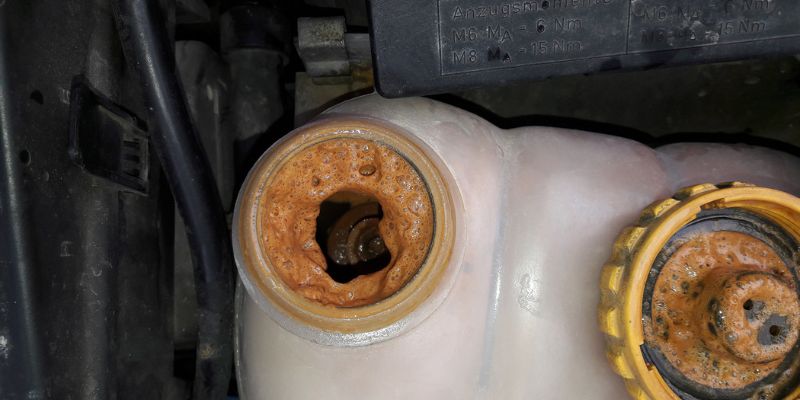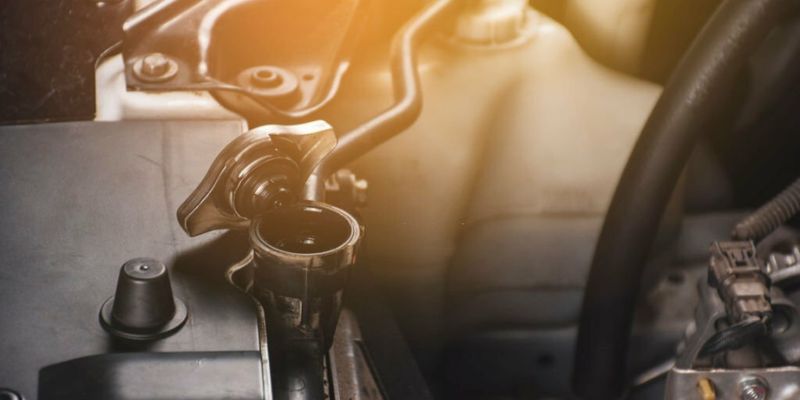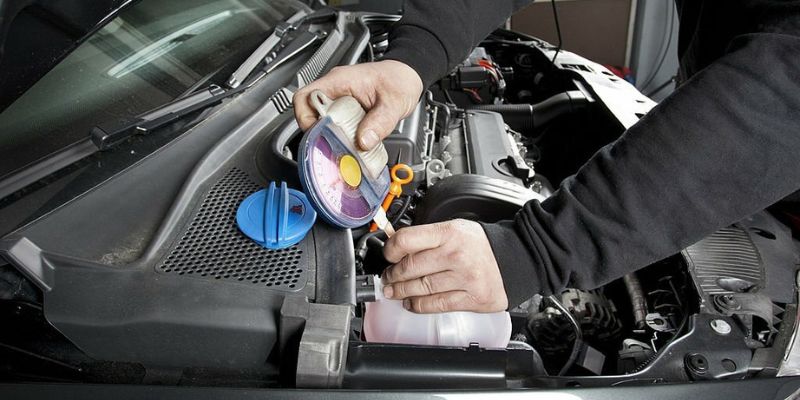Cooling system flush removes the contaminants like debris, rust, and mineral deposits that accumulate in the coolant system and compromise the cooling efficiency.
Neglecting coolant flushing can lead to overheating issues down the road. As deposits clog radiators and gunk build in the engine, it takes more effort for coolant to transfer heat away from critical components.
Dirty, discolored fluid is a significant sign you need a coolant flush. By flushing away accumulated grime, you save your engine from potential overheating calamities. But first, you need to know when it’s time to flush the radiator.
In this article, we will guide you through all the symptoms of your car needing a radiator flush. Additionally, we will guide you with the coolant flushing method and the components required.
What is a Coolant Flush?
A coolant flush is a maintenance procedure that involves draining old coolant from an engine’s cooling system and refilling it with new coolant.
The cooling system is first drained and special flush fluids are circulated through it using a coolant flush machine. Flushing machines provide a powerful cleaning action. They pump flush fluid under pressure to break up accumulated sludge and flush it out.
As the machine circulates, the flush fluid works to dissolve rust, scale, and other residues. After thorough cleaning, the new antifreeze is filled in the coolant reservoir.
Importance of a coolant flush
A coolant flush is vital for the optimal working of the car’s cooling system, otherwise, the vehicle’s engine gets contaminated and ultimately disturbs the engine performance.
Over time, contaminants like rust, scale, and mineral deposits slowly accumulate in the cooling system. This includes the radiator, coolant passages in the engine block, and all connecting hoses and pipes.
Left unchecked, these deposits can gradually restrict coolant flow and reduce the system’s ability to transfer heat away from the engine. Even a minor clog can cause temperatures to rise.
As heat is not dissipated effectively, components like the head gaskets, cylinder walls, piston rings, etc. are more susceptible to damage from excessive heat over long periods.
The buildup also diminishes the coolant’s protective qualities. Its anti-corrosion additives become compromised, accelerating corrosion within the metal cooling system parts.
Regular coolant flushes, usually every 2-3 years or 30k miles, are recommended to remove these contaminants before major issues arise.
What is a coolant flushing machine?
A coolant flush machine is a portable device designed specifically for flushing cooling systems.
It works by circulating a flushed fluid, sometimes also called a flush solution, through the radiator, engine block, and entire cooling system under pressure.
As it circulates, the flush solution loosens and lifts debris out of hard-to-reach areas that simple water drainage cannot reach.
The machine has separate tanks – one to hold the flush fluid and another to collect the dirty fluid from the system during flushing.
This closed-loop circulation prevents flushed debris from being pushed back into the system.
What is flush fluid?
Flush fluid is a formulated chemical solution specifically designed for flushing out cooling systems.
It works by breaking down and emulsifying deposits like rust, scale, mineral buildup, and leftovers from old coolant/antifreeze. Common active ingredients include alkaline compounds like phosphates and silicates that help dissolve carbonates and metal oxides in residue.
Signs You Need a Coolant Flush
The normal coolant flush time is every 3 to 5 years or every 30,000 miles, whichever comes first. But it’s not necessary to flush the system only for these two conditions. There are many other signs that your car needs a coolant flush.
Here are some signs that it may be time for a coolant flush:
1. Engine overheating
If your engine temperature gauge shows higher than normal readings, even when the coolant level is full, it’s a sign that residue buildup inside the system is reducing its ability to dissipate heat efficiently. A flush can restore full cooling function.
2. Coolant discoloration
Over time, coolant will naturally darken as it does its job. But if it appears dirty, rusty, or muddy well before recommended change intervals, it indicates contamination that a flush would remove.
3. Sputtering/rough engine
Mineral deposits left unchecked can disrupt proper coolant circulation, potentially causing erratic temperature changes that affect engine performance. Flushing ensures smooth flow.

4. Rusted radiator
Excessive corrosion seen on external radiator surfaces or internally signals the coolant protection has been compromised and restoration is needed.
5. Overdue service interval
Manufacturer recommendations call for flushing every 3-5 years or 30,000 miles for prevention. Following the schedule is prudent maintenance.
What happens during a coolant flush?
Here are the key steps that typically occur during a coolant flush:
1. Draining the old coolant
A technician will disconnect hoses and drain all old coolant from the radiator, engine block, and entire cooling system. This may take over an hour to fully empty.
2. Flushing with water
Distilled water is flushed multiple times through the system to rinse away residue left behind by the old coolant. Pressure may be applied to help dissolve debris.
3. Flushing with flush fluid
A commercially formulated flush solution is circulated to break up mineral deposits, rust, and other obstructions not removed by water alone.
4. Using a flush machine
For tougher jobs, a machine circulates the flush solution under pressure to penetrate narrowed passages better. Waste is collected separately.
5. Inspecting for debris
The technician checks that the flushing process has sufficiently removed contaminants by examining the flushed fluid.
6. Checking for leaks
Hoses and connections are inspected for coolant leaks that may have developed due to aging seals or corrosion.
7. Refilling with new coolant
Once clean, the system is refilled with a new pre-diluted coolant mixture that protects against corrosion and maintains optimal temperature.
Can I do a coolant flush myself?
Yes, you can do a coolant flush by yourself rather than going to a mechanic shop, but you need to understand the whole process of coolant flushing. The step-by-step method of DIY flushing includes technical knowledge of the coolant system.
DIY Coolant Flushing Method
Before doing coolant flushing by yourself, you need to prepare these necessary tools and equipment:
Tools:
- Socket set – To remove hoses and drain plugs
- Screwdrivers – Loosening clamps if necessary
- Pliers – Removing/installing hoses and clamps
- Funnel – For filling coolant components
- Flashlight – Illuminating hard-to-see areas
- Rag – To clean up spills
Materials:
- Drain pan – To catch the old coolant
- Distilled water – For multiple rinse cycles
- Coolant flush solution – Dissolves mineral deposits
- Premixed coolant – Refill system after flushing
- Hose clamps – Replace as needed when reinstalling
- Funnel – For accurate pouring into the radiator/reservoir
- Coolant tester – Checking new coolant concentration
Other Supplies:
- Gloves – Protecting from chemicals
- Safety glasses – Prevent splashing in eyes
- Rags – Wiping and cleanup
- Funnel – Pouring precisely into the radiator
- Refractometer – Testing coolant concentration
Here is the step-by-step guide on the DIY coolant flushing method:
1. Drain the coolant
Place a drain pan under the radiator drain plug and open it to drain the old coolant. You can also remove hoses.
2. Flush the radiator with water
Fill the radiator with distilled water and run the engine to circulate it. Drain and repeat 2-3 times to rinse residue.
3. Add flush solution
Fill the radiator halfway with a flush solution. Loosen the drain plug slightly to circulate it through. Let sit for 30 mins.
4. Circulate flush
Remove the radiator cap and start/run the engine for 5-10 minutes to flush with solution.
5. Drain flush solution
Drain fluid from the radiator and engine block once circulation is complete. Dispose of the coolant properly to prevent any damage. The coolant disposal method is present in the later part of this article.
6. Refill with water
Refill the radiator with distilled water and run the engine to circulate and flush residual chemicals.
7. Replace hoses and plugs
Reinstall any removed hoses, clamps, and drain plugs ensuring tight seals.
8. Refill with coolant
Pour premixed coolant into the radiator until full. Replace the radiator cap.
9. Bleed air bubbles from the system
Let the engine idle with the heat on full until the thermostat opens fully, about 15 minutes.
10. Check fluid levels
Top off coolant as needed and inspect for leaks. Allow to cool before driving.
Taking your time with multiple rinses/flushes removes buildup thoroughly for safe, smooth operation.
How often should you get a coolant flush?
The time for a coolant flush depends on multiple factors like mileage, coolant condition, and time of last flush. Here are some situations in which your car needs a coolant flush.
- As a general rule, you should get your car’s cooling system flushed every 30,000 miles or every 3 to 5 years – whichever comes first.
- After an overheating event – Overheating stresses a system. It’s best to flush promptly after removing any additional debris.
- When coolant looks dirty – If the coolant appears contaminated or discolored during routine fluid checks, it’s likely time for a flush.
Coolant flush cost
The cost of a coolant flush depends on several factors:
The vehicle’s coolant capacity
Larger vehicles like trucks and SUVs which hold more coolant will generally cost more than smaller cars. The more coolant a system holds, the more it will cost to flush and refill.
Flushing method
A basic fluid exchange flush costs less than a flush that involves adding chemical flush solutions or radiator cleaner soap before draining and refilling. The extra chemicals and labor of multiple drain/fill cycles increase the cost.
Shop vs DIY
Doing the flush yourself will be much cheaper since you only pay for flush fluids and coolant. Taking it to a repair shop adds their labor rate which can be $80-120 per hour on average. Expect to save $50-100 by performing the flush yourself.
Additional repairs
If components like hoses, thermostats, or water pumps need replacing based on age or condition, those extra parts and labor will increase the price. A basic flush is just fluids; anything else pushes the cost higher.
Typically, for a basic coolant flush on an average passenger vehicle conducted at a repair shop, you can expect to pay between $100-150.
Flushing systems with a larger capacity, additional components, or chemical treatments may cost $150-250 depending on the vehicle and shop.
DIY options provide the most affordable solution and it can cost you $50-100.
Benefits of a Coolant Flush
Here are some of the main benefits of performing a coolant flush:
Improved heat transfer
Dissolves mineral deposits and flushes residues to allow coolant to more efficiently transfer heat from the engine.
Prevent overheating
Removes coolant bubbles trapped in the coolant system that can lead to clogged radiators and inability to properly cool the engine.
Increased protection
Flush replaces old coolant with new that is chemically balanced to prevent corrosion within the system.

Extended service life
By removing damaging residue, a flush allows the cooling system to last longer before repairs are needed.
Enhanced performance
Efficient heat dissipation allows the engine to run at proper temperatures for maximum power and fuel efficiency.
Avoid costly repairs
Catching small problems early through flushing prevents more serious issues down the road that require the removal and replacement of parts.
Recommended coolant disposal methods
Here are some details on recommended coolant disposal methods:
- Never pour automotive coolant directly onto the ground, as it can contaminate soil and groundwater. Coolant contains ethylene glycol, which is toxic to plants and animals in large amounts.
- Most auto parts stores and garages offer coolant recycling for a small fee. This is the best option, as recycled coolant goes through a purification process before being reused.
- If recycling isn’t available, absorb spilled coolant with an inert material like kitty litter or sawdust and dispose of it in your regular trash. The absorbent will prevent leaks into the landfill.
- For small amounts left in a radiator or overflow reservoir, add a sewer cleaning chemical containing enzymes before rinsing to municipal sewer lines with water. This helps break down residual coolant before it reaches treatment plants.
- Never put coolant down household or public drains without pre-treating, as it can interfere with septic or sewage treatment.
- Some communities hold mobile toxic waste collection events where automotive fluids like coolant can be disposed of properly. Check with your local waste management department.
- As a last resort, undiluted coolant can be dried out and disposed of in regular trash if fully absorbed, but recycling is always the most eco-friendly option.
Let me know in the comments if you need any part of the disposal guidance expanded upon or clarified further. Proper handling is important.
Benefits of using a Coolant flushing machine vs water flush
Here are some advantages of using a coolant flush/flushing machine over just flushing with water:
- Thorough cleaning power – Commercial flush machines circulate coolant flushing solution under pressure to help break up mineral deposits, rust, and other buildup more effectively than gravity draining with water.
- Removes all traces – Dedicated flush solutions are formulated to neutralize old coolant residues and remove them from the system rather than just diluting them like water can. This restores optimal protection.
- Prevents re-contamination – Flushing with used coolant water risks redepositing loosened debris. Flush machines capture flushed debris rather than swishing it back into the system.
- Quick and complete – The high-volume pressurized flow of a machine flush can clean a full system much faster than multiple water changes. It helps ensure no residual old coolant is left behind.
- Extends new coolant life – Thoroughly removing all old residues prevents them from interfering with the new coolant’s ability to inhibit corrosion and protect the system.
- Prevent clogs and damage – Flushing machines can help clear severely blocked areas better than water to prevent damaging loosened debris from clogging important cooling system components.
- Gear for the job – Portable machines are compact yet powerful, with features like integrated coolant recycling ideal for professional or DIY full-system deep cleaning.
How long does a coolant flush take?
For most cars and light trucks, a basic coolant flush takes 1-2 hours for the mechanic to drain the old fluid, flush out the system with fresh solution, and refill with new coolant.
More complex jobs that require component removal or have heavy deposits may take 2-4 hours due to additional drain/flush cycles needed.
What happens if you don’t flush coolant?
If you don’t flush your coolant for a long time and keep driving your car, it will cause multiple problems like mineral deposits, radiator corrosion, and engine stalling.
Here are potential issues that can happen if you don’t flush your coolant periodically:
1. The buildup of scale and deposits.
Over time, mineral deposits from hard water accumulate in the cooling system. This reduces heat transfer and can clog radiators, hoses, and water jackets.
2. Corrosion of metals
Deposits make coolant more acidic, accelerating corrosion of the aluminum, steel, and other metals used in the engine. This weakens components over the long run.
3. Overheating issues
Deposits act as insulation, impairing the coolant’s ability to dissipate heat efficiently. This can cause occasional or chronic overheating problems.
4. Water pump/thermostat problems
Deposits can eventually jam up and interfere with the operation of these vital cooling system parts.
5. Reduced coolant life
Without flushing, coolant may need replacement much sooner than the recommended 100k-150k mile interval.
Can a radiator flush cause problems?
Yes, there is a possibility that a radiator flush could cause some problems if not done properly.
One issue is that flushing liquid and loosened debris can sometimes dislodge material that has hardened in place. If this disturbed debris is not fully drained afterward, it could get recirculated and potentially clog smaller cooling passages.
If the flush water or chemicals used are not contaminant-free, they could spread that contamination throughout the entire cooling system instead of removing existing residues.
Aggressive flushing may also weaken corrosion that has built up and bonded over time. This could cause loosened corroded particles to circulate where they were previously immobile.
Will a coolant flush cause leaks?
Yes, a coolant flush could potentially cause leaks. Old seals and gaskets that have been weakened over time are at risk of cracking or splitting during the disassembly and reassembly of the cooling system.
Aggressive flushing may also disturb mineral deposits that have formed, which could damage seals.
Final Verdict
A coolant flush is essential to maintaining your vehicle’s cooling system health. Over time, residue builds up that the coolant cannot remove on its own. This clogs vital passages and chars hoses from excess heat.
Without flushing, your thermostat may seize and the water pump gets jam due to debris. Engine damage results as coolant Is compromised, no longer protecting metals from corrosion. Flush your vehicle’s radiator every 2 years or 30,000 miles for maximum effect.

Hi, Michael Williams here. I have always loved everything with an engine. After earning my degree in automotive engineering, I spent 5 years testing vehicles for a major manufacturer in Illinois. Now I am using my technical skills to review the latest models online and help others troubleshoot their engine problems with effective solutions.
